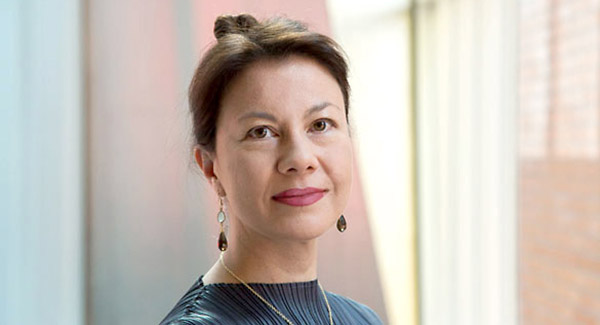COMPUTING AND AI: HUMANISTIC PERSPECTIVES FROM MIT
Global Languages | Emma Teng, with colleagues

Emma Teng, T.T. and Wei Fong Chao Professor of Asian Civilizations; photo by Jon Sachs
"Language and culture learning is a gateway to international experiences and an important means to develop cross-cultural understanding and sensitivity. Such understanding is essential to addressing the social and ethical implications of the expanding array of technology affecting everyday life across the globe."
— Emma Teng, T.T. and Wei Fong Chao Professor of Asian Civilizations
Series | Computing and AI: Humanistic Perspectives from MIT
Emma J. Teng is the T.T. and Wei Fong Chao Professor of Asian Civilizations and a MacVicar Faculty Fellow at MIT, where she teaches courses in Chinese culture, Chinese migration history, Asian American history, East Asian culture, and women’s and gender studies. Her most recent book is Eurasian: Mixed Identities in the United States, China and Hong Kong, 1842-1943 (University of California Press, 2013).
. . .
Q: What are some examples of domain knowledge, perspectives, and methods from language and culture studies that should be integrated into the research and curriculum of the Schwarzman College of Computing and why?
Language and culture learning is a gateway to international experiences and an important means to develop cross-cultural understanding and sensitivity. Such understanding is essential to addressing the social and ethical implications of the expanding array of technology affecting everyday life across the globe.
Consider that in China today, you can pay for groceries and check in for a flight using cutting-edge facial recognition technology — technology that also enables new forms of state surveillance and control. Germany deploys innovative language biometrics software to screen asylum-seekers; in the hands of agents without extensive training in linguistic analysis, will it pose unintended obstacles for refugees fleeing war-torn homelands?
The malevolent use of technology and its unintended consequences are growing concerns all over the world as technological innovation progresses at an ever-quickening pace. The study of global cultures and languages provides a strong foundation for addressing the kinds of questions, including the following, that are emerging within this cross-cultural context:
- What are the implications of using robots for elder care in Japan?
- What are the social and political consequences of internet censorship in countries from China to Russia to Egypt?
- How can social media be used — even under repressive regimes — to make incremental social change?
- What are the ethics of American artificial intelligence (AI) researchers utilizing Chinese big data and how do we assess U.S. corporate complicity in Russia’s disinformation campaigns?
Such inquiry demands expertise in both specific area studies and in comparative analysis — hallmarks of our field.
Speech and language are fundamental to human identity; today, the interface between computing and natural languages is one of the most dynamic areas of research and development. As Ben Gomes, head of Google Speech, has said: “Speech recognition and the understanding of language is core to the future of search and information.” While new technologies are making language study and inter-language communication increasingly accessible, it is crucial to consider the possible social impacts.
Can the facility of technology-enabled language learning change the concept of “first language” and the way it shapes an individual’s understanding of and outlook on the world? Will the ease of communication with individuals around the globe — either through acquired language or machine translation and interpretation — affect ideas of national identity?
These are only a few examples of areas in which the domain knowledge central to 21G might inform research on human language technologies and their global application.
In addition, it’s important to recognize the dominant role that the English language has played to date in the computer science field. This can lead to blind spots: for example, the Chinese language was long believed, by English speakers, to possess inherent obstacles to computing; and yet China has surged ahead to become a global leader in AI voice and speech recognition technology.

Action
"Create a 21st-century language center at MIT to provide a convening space for cross-cultural communication, collaboration, action research, and global classrooms."
Q: What are some of the exciting, meaningful opportunities that advanced computing is making possible in your field?
Recent advances in natural language processing (NLP), speech recognition, chatbots, and virtual or mixed reality (XR) technologies hold enormous potential for transforming foreign language and culture pedagogy for the 21st century. Building on a long history of innovation in technology-enhanced language pedagogy at MIT, we are poised to ask: What will global language and culture education look like 10 years from now?
Senior lecturer of Spanish Margarita Ribas Groeger envisions a field that will be “even more mobile, personalized, and collaborative thanks to the increasingly effective use of digital tools, while virtual environments will allow for more contextualized and interactive learning experiences. At the same time, the boost in immersive international programs, which combine language study with internships or volunteer projects abroad, will advance students’ language and intercultural communicative competence.”
Senior lecturer of Japanese Takako Aikawa predicts the transformation of language education as students turn to “AI language buddies” on their mobile phones to practice conversation, test grammar, and build vocabulary on the go. Aikawa’s AI Language Teacher project explores how data-driven learning integrating corpus linguistics can be utilized to develop new analytical tools for understanding how learners interact with diverse textual formats and media as well as with others in a community of learners.
Already the community of language learners is expanding as the accessibility of video-conferencing technologies facilitates real-time interaction with peers in a “global classroom.” Speech recognition tools also enable students to practice language skills outside the classroom and receive real-time feedback and correction on pronunciation and tone. XR applications allow for kinesthetic learning where students can "learn by doing" or "playing" in the target language within an immersive virtual environment.
These advances enable institutions to rethink the traditional language lab; Joseph Borkowski, systems administrator for 21G, distinguishes the 21st-century language center as one that goes beyond the old model of single-occupancy workspaces to provide a convening space for cross-cultural communication, collaboration, and action research.
While new technologies promise to advance our field, face-to-face human interaction is irreplaceable. As Dean of Science Michael Sipser has noted, teaching “is really about human connection” — and nowhere is this more important than in the study of languages and cultures. For that reason, students will still be served best by the intimate size and environment of the classes offered in 21G. Such a high-touch educational experience will only increase in value as the world becomes ever more saturated with technology.
Suggested Links
Series | Computing and AI: Humanistic Perspectives from MIT
Emma Jinhua Teng
MIT Global Languages
MIT Schwarzman College of Computing
Related Publications
Eurasian: Mixed Identities in the United States, China, and Hong Kong 1842-1943 by Emma Jinhua Teng (UCal Press, 2013)
Global Languages (21G) major writes senior thesis
Series prepared by MIT SHASS Communications
Office of Dean Melissa Nobles
MIT School of Humanities, Arts, and Social Sciences
Series Editor and Designer: Emily Hiestand, Director of Communications
Series Co-Editor: Kathryn O'Neill, Associate News Manager
Published 23 September 2019